Bernedoodle Vs Goldendoodle (8 Key Differences)
Thinking of adding a curly-furred family member and torn between a Bernedoodle and a Goldendoodle? You’re in luck! This definitive showdown compares puppy costs, grooming needs, size, and more to help you decide which popular designer dog fits your lifestyle and family.
Find out which breed is perfect for your family!

Key Differences
- Breed Origin & Cost Bernedoodles are a mix of Poodles and Bernese Mountain Dogs, costing around $3,500. Goldendoodles blend Poodles and Golden Retrievers, usually costing $2,000. Both are great with kids and other dogs, but Bernedoodles are pricier.
- Size & Build Bernedoodles are generally larger, weighing 55-90 pounds and standing 23-29 inches tall, thanks to their Bernese Mountain Dog genes. Goldendoodles weigh 40-60 pounds and stand 20-24 inches tall. Size matters depending on your living space and lifestyle.
- Health Considerations Bernedoodles may face hip or elbow dysplasia and are more prone to blindness in older age. Goldendoodles are susceptible to ear infections and dental issues. Each breed has distinct health risks to consider for long-term care.
- Energy Level Goldendoodles are typically more energetic and may require more playtime and exercise. Bernedoodles tend to be more laid-back, making them a better fit for a relaxed lifestyle.
- Grooming Needs Both breeds need regular grooming, but Bernedoodles have a thicker coat that may require more frequent brushing and professional care. Goldendoodles generally have easier-to-manage coats.
- Size Variations Goldendoodles offer more size options, including mini, medium, and standard. Bernedoodles are commonly found in standard and mini sizes, providing fewer choices for potential owners.
The Bernedoodle and Goldendoodle are crossbreeds that have rapidly gained popularity, each offering unique traits. So the question arises, which one is the better canine companion?
Key Similarities:
- Both breeds are friendly to humans and other animals.
- They are highly trainable and generally well-behaved.
- Each boasts a low-shedding coat that’s close to hypoallergenic.
Both of these breeds are in high demand and make energetic, family-friendly, and healthy pets. There’s no clear ‘winner’ in the Goldendoodle vs. Bernedoodle debate. Each has its own set of amazing qualities, and understanding these differences will equip you to make an informed choice about the perfect fit for your family and lifestyle.
Breed Comparison: Bernedoodle Vs Goldendoodle
| Goldendoodle | Bernedoodle | |
|---|---|---|
| Lifespan | 10-15 Years | 8-12 Years |
| Color Variations | Gold, Caramel, Red, Cream, Phantom, Apricot | Tri-Colour (Jet Black, Clear white, Rust) |
| Temperament | Social, Happy, Trainable, Devoted | Social, Friendly, Strong Minded, Protective |
| Other Names | Groodle | Bernese Mountain Poodle |
| Height | Miniature 13-20″, Small Standard 17-20″, Large Standard 20-24″ | Tiny 12-17″, Mini 18-22″, Standard 23-29″ |
| Weight | 40-60 Pounds | 55-75 Pounds |
| Friendliness | Very Friendly | Very Friendly |
| Price | $1500 + | $2500 + |
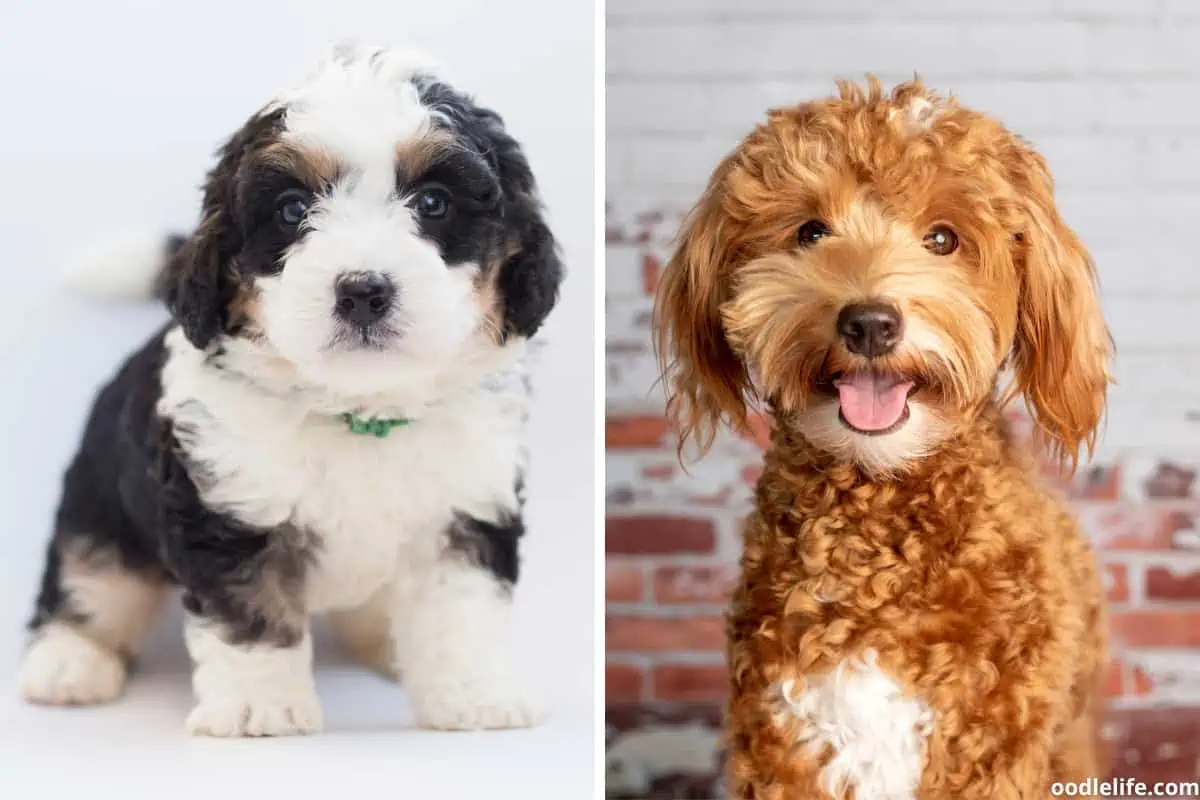
History
A crossbreed is also known as a ‘hybrid’ or ‘designer dog’. This means that Bernedoodles and Goldendoodles are both ‘mash-up’ breeds. Many of their defining characteristics come from their two breeds of heritage.

Crossbreeding can be unpredictable. In a perfect world, the crossbreed Puppy inherits looks and traits from both parents.
Your Bernedoodle or Goldendoodle could end up very similar to a Poodle. The same Puppy could also resemble a Bernese Mountain Dog or Golden Retriever. A lot of crossbreeding comes down to luck.
The Bernedoodle is a relatively new crossbreed, first intentionally bred in the early 2000s by Sherry Rupke of Swissridge Kennels. The aim was to create a dog that combined the best attributes of the Bernese Mountain Dog and the Poodle, namely the Bernese’s friendly disposition and the Poodle’s hypoallergenic coat. Since its inception, the Bernedoodle has gained popularity for being a lovable, low-shedding family companion.
On the other hand, the Goldendoodle has its roots in the 1990s and was initially bred in North America and Australia. The objective was similar—to blend the friendly and loyal nature of the Golden Retriever with the low-shedding, hypoallergenic qualities of the Poodle. This mix rapidly gained attention and is now one of the most popular designer breeds, highly prized for its sociability, intelligence, and low-shedding coat.
Appearance
Goldendoodle and Bernedoodle Dogs are incredibly beautiful. They come in many varieties, and different coat types and colours.

A Bernedoodle often resembles a plush, shaggy teddy bear with its distinctive coat. This coat is usually a unique blend of three colors: jet black serves as the dominant hue, offset by clear white markings and striking splashes of rust.
The fur itself can range from curly to wavy, adding to its cuddly appearance. While the tri-color pattern aims to mimic that of the Bernese Mountain Dog, it’s worth noting that this particular color scheme can be somewhat unpredictable.
A Goldendoodle often sports a solid coat that most commonly radiates a golden sheen. However, this breed’s coat can also come in a range of other colors, including black, copper, apricot, red, white, cream, or gray. The texture of the fur can vary, often either wavy or curly, which contributes to its charming appearance.
Unlike the Bernedoodle, which has a broader array of color combinations, the Goldendoodle’s coat is usually a solid hue, making it less variable in terms of color patterns.
When it comes to size, Bernedoodles are generally larger due to their Bernese Mountain Dog heritage. A standard Bernedoodle can weigh between 55 and 90 pounds and stand 23 to 29 inches tall. In contrast, a standard Goldendoodle weighs between 40 and 60 pounds and has a height range of 20 to 24 inches.
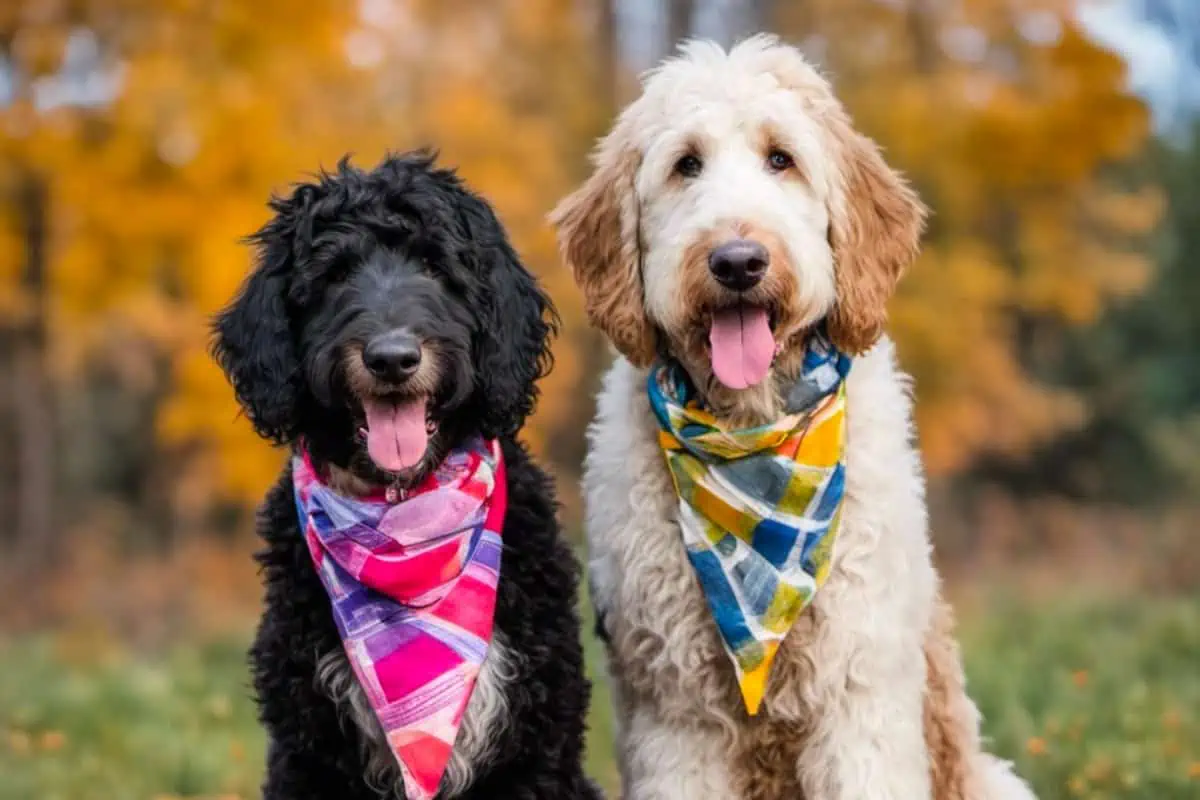
Overall, Bernedoodles offer a more varied and vibrant color pattern but are generally larger in size, while Goldendoodles present a more uniform coat color and are typically smaller and lighter.
Most breeders attempt to balance the stoic and stocky Bernese Mountain Dog build with the lithe and sleek Poodle frame. Finding this middle ground gives a fairly predictable shape and size. The size depends greatly on how large the Poodle parent was.
Editors note from Chris – There is a lot of confusion about Bernedoodles vs Australian Bernedoodles. I asked an expert breeder to expand –
Jacinta Allen, a Bernedoodle breeder, notes, “A Bernedoodle puppy is different than an Australian Bernedoodle. They look similar but are not the same. They are different breeds.” An Australian Bernedoodle is a cross between a specific type of Labradoodle called an Australian Labradoodle and a Bernese Mountain Dog.
Size
The size of both of these breeds will depend on the size of the parents and a healthy dose of genetic luck.

Breeding Bernedoodles or Goldendoodles is unpredictable. It is very possible to have 50 pound (22kg) parents and end up with either a 35 pound (15.5kg) OR a 70 pound (32kg) dog.

| Size/Breed | Height Range (inches/cm) | Weight Range (pounds/kg) |
|---|---|---|
| Tiny Bernedoodle | 12-17 inches / 30.5-43.2 cm | 10-24 pounds / 4.5-10.9 kg |
| Mini Bernedoodle | 18-22 inches / 45.7-55.9 cm | 24-49 pounds / 10.9-22.2 kg |
| Standard Bernedoodle | 23-29 inches / 58.4-73.7 cm | 70-90 pounds / 31.8-40.8 kg |
| Miniature Goldendoodle | 13-20 inches / 33-50.8 cm | 15-35 pounds / 6.8-15.9 kg |
| Small Standard Goldendoodle | 17-20 inches / 43.2-50.8 cm | 40-50 pounds / 18.1-22.7 kg |
| Large Standard Goldendoodle | 20-24 inches / 50.8-61 cm | 50-90 pounds / 22.5-41 kg |
Temperament
When it comes to temperament, both Bernedoodles and Goldendoodles are incredibly sociable, friendly, and excellent with children. They’re not your go-to breeds if you’re looking for a guard dog; their innate friendliness tends to overshadow any guarding instincts.

The Bernedoodle’s ancestry does bring with it a degree of stubbornness, inherited from the Bernese Mountain Dog side of the family. This strong-willed nature may require a bit more patience and consistent training, but it’s nothing an experienced dog owner can’t manage.
Intelligence is a hallmark for both of these breeds. With Poodles, Bernese Mountain Dogs, and Golden Retrievers as their parent breeds, it’s no wonder these crossbreeds are quick learners. However, this intelligence means they can get bored easily, so mental stimulation is key.
Separation anxiety is another shared trait, making them less suitable for families or individuals who spend long periods away from home. The Bernedoodle, in particular, is not the best option if extensive time will be spent apart.
Apartment Suitability
Bernedoodles and Goldendoodles can adapt to apartment living, but some key considerations exist.
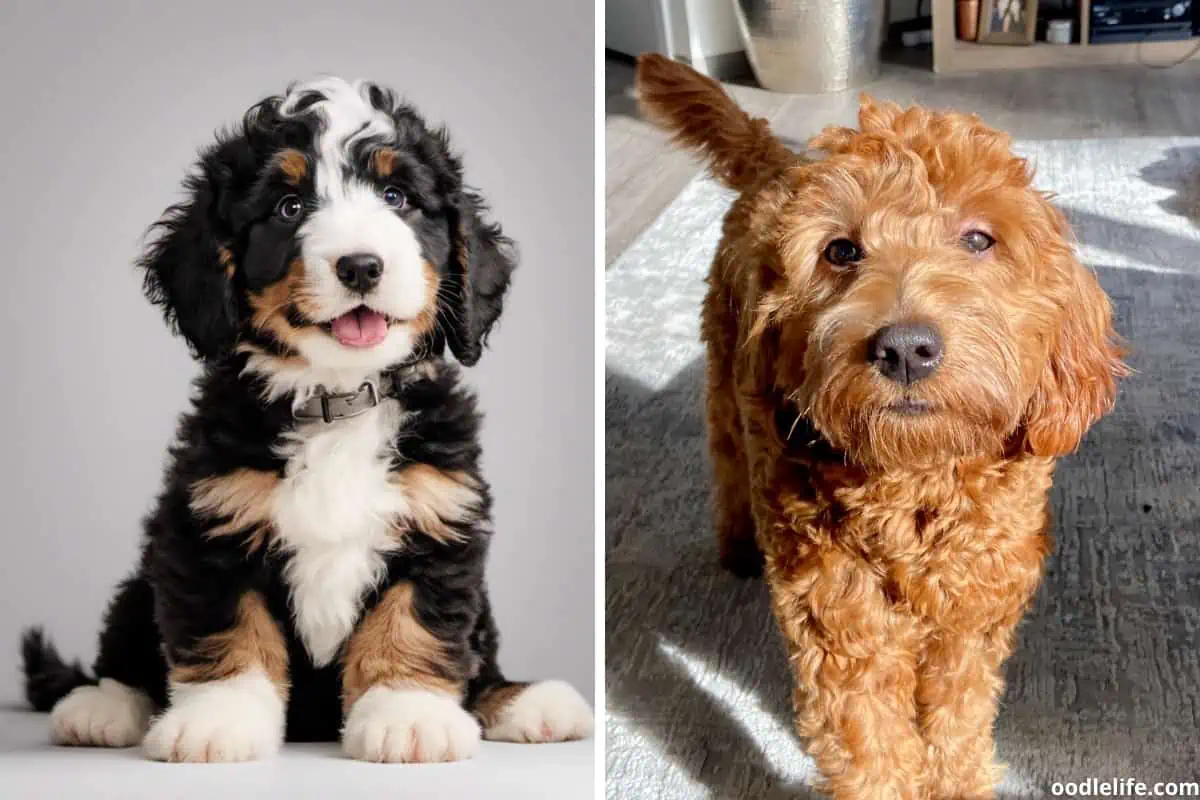
Daily exercise is a must for these energetic breeds, with larger Bernedoodles and Goldendoodles requiring even more physical activity. If you’re living in an apartment, both breeds’ miniature or toy sizes are more manageable in terms of space and exercise needs.
Poodles are known for their high energy levels, and this trait can be passed down to both Bernedoodles and Goldendoodles. If you end up with a particularly energetic pup, you could find yourself needing to provide more exercise than initially expected.
Another factor to consider is bathroom frequency. Apartment dwellers might benefit from a DIY porch potty to ease the toilet training process and meet the dog’s needs.
Regardless of size, plan for at least an hour of play or exercise daily. This can be scaled back if you find your dog doesn’t require as much activity, but it’s better to start with more and adjust as needed.
In conclusion, while both breeds can thrive in apartment settings, miniature and toy sizes are generally more suited for smaller living spaces. Goldendoodles, often available in more size variations, might offer a slight edge for apartment dwellers looking for a dog that aligns closely with their lifestyle needs. Exercise, grooming, and toilet training are important factors for both breeds, so be prepared for these responsibilities.
Exercise Needs
Both Bernedoodles and Goldendoodles need about an hour of exercise each day for optimum health. However, their exercise preferences can differ. Goldendoodles usually have a love for water, making them great companions for swimming or boating. On the other hand, Bernedoodles enjoy activities that engage their strength and stamina.

Bernedoodles may be a bit more laid-back, sometimes requiring less mental stimulation compared to Goldendoodles. While the Bernedoodle’s larger size may make them content with less vigorous exercise, it’s not a guarantee; much depends on individual temperament.
Both breeds are highly intelligent and will benefit from a variety of toys, especially interactive and puzzle toys that can keep them mentally engaged. Keeping them well-stimulated will make them happy and help prevent destructive behavior.
Training Challenges
For potty training, both breeds benefit from a consistent routine. Goldendoodles are generally easier to train in this area due to their eagerness to please. Bernedoodles may require a bit more patience because of their more stubborn nature.
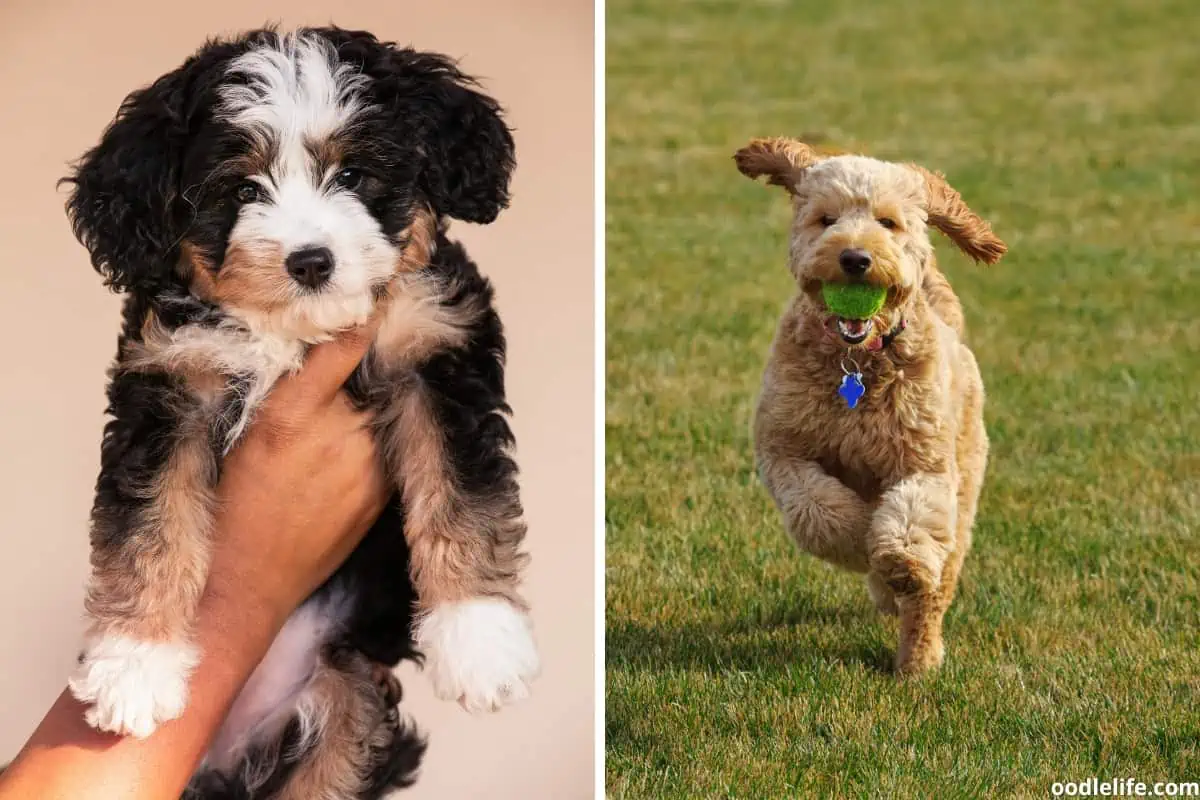
When it comes to general training, Goldendoodles are usually more willing to follow commands and are a good choice for first-time dog owners. Bernedoodles can be more independent and may pose a training challenge; they are better suited for those experienced in handling strong-willed dogs.
Both breeds require consistent socialization to grow into well-mannered adults. Bernedoodles tend to be more reserved around strangers and need lifelong socialization to prevent overprotectiveness. Positive reinforcement works well for both breeds, and they both enjoy treat-based rewards.
Both Bernedoodles and Goldendoodles would enjoy a crate as their personal haven, but it’s not as vital for a Goldendoodle. On the other hand, crate training is especially beneficial for Bernedoodles to alleviate their anxiety and safeguard your furniture when you’re not around.
For leash manners, it’s critical to train both breeds, but it’s particularly imperative for Bernedoodles who have a natural propensity to pull strongly on the leash. If not properly trained, they may end up taking you for a walk, rather than the other way around!
Allergies
As a family dog expert, I always get asked about shedding and allergies. No dog is truly hypoallergenic. All dogs have dander – some just shed less of it.

Both Bernedoodles and Goldendoodles are solid choices for individuals with allergies or asthma, largely thanks to their Poodle heritage. Poodle coats tend to produce fewer allergens, although it’s essential to remember that no dog breed is completely hypoallergenic.
Bernedoodles can sometimes shed, so if allergies are a concern, you might want to look into F1B Bernedoodles or multigenerational Bernedoodles. These have a higher percentage of Poodle genetics, which reduces the likelihood of shedding and allergic reactions. However, more Poodle in the mix could mean less of the distinct tri-color Bernese appearance that many people find appealing.
Goldendoodles do offer various hypoallergenic and non-shedding options. The F1B Goldendoodle is often recommended for those with allergies, as this type has been bred back with a purebred Poodle, further increasing the Poodle genetics and reducing the chances of shedding.
Both breeds are allergy-friendly to an extent, but if minimizing allergens is your primary concern, an F1B Goldendoodle could be a slightly better fit due to its higher Poodle genetic content.
Health Problems
Bernedoodles and Goldendoodle are generally healthy dogs. Neither is well known for significant health issues. You need to know that crossbreeds are still prone to the health conditions of their parent breeds.

As a family dog expert who has advised hundreds of adoptions, I always encourage open conversation with the breeders about any family history of illness. My experience shows that breeders love their dogs and will often share full details that you can pass on to your Vet.
The following conditions are ones to watch out for. In general, though, regular Veterinarian checks will screen and catch these early.
Bernedoodles are prone to
- Canine Hip Dysplasia (CHD)
- Elbow dysplasia
- Eye troubles in Progressive Retinal Atrophy
(More Bernedoodle health information is listed at the Canine Journal.)
Both Golden Retrievers and Bernese Mountain dogs have a higher risk of cancers. Regular veterinary checkups are strongly recommended to catch these early.
The Canine Journal study states that “Bernese Mountain Dogs have a higher incidence of death by cancer than other breeds with up to 50% of Berners dying of the disease, 20% more than the rest of the canine kingdom”.
Golden Retrievers are more prone to
- Canine Hip Dysplasia (CHD)
- Hypothyroidism
- Eye disorders
- General issues with skin health
(More Golden Retriever Health information at PetMD.com)
They are also affected more frequently by cancers than the average canine.
Poodles are more prone to
- Skin tumours (typically benign)
- Canine Hip Dysplasia (CHD)
- Epilepsy
- Addison’s Disease
(The Poodle Club of America list more Poodle health concerns, as does the Pedigree pet food company.)
Nutrition and Food Consumption
Both Bernedoodles and Goldendoodles have active lifestyles that require high-quality, high-protein kibble. Goldendoodles usually consume 3-4 cups of kibble per day, while Bernedoodles eat slightly more, around 4-4.5 cups daily. Given their high energy levels, it’s crucial that their food packs a protein punch for sustained vitality.

Digestive health is another important factor for these breeds, as both tend to have sensitive stomachs. Opt for kibbles enriched with prebiotic fibers and probiotics to support their digestive systems.
Lastly, both breeds are known to be food-motivated. Monitoring their weight is important to prevent obesity, especially considering their penchant for treats. Incorporating healthy snacks like carrots can satisfy their appetite without packing on the pounds.
In summary, both breeds have similar nutritional needs but Bernedoodles may require a bit more food. High-protein, easy-to-digest kibbles are ideal for both, and mindful treat management is crucial due to their hearty appetites.
Lifespan Differences
The Goldendoodle and the Bernedoodle are hardy and healthy dogs with long lifespans. The smaller size hybrids live longer. Extra large Goldendoodle or Bernedoodles tend to live shorter lives.
- Goldendoodles tend to live 10-15 years with smaller dogs living longer.
- Bernedoodles tend to live 8-12 years with smaller dogs living longer.
Lifespans of the Purebred parents dogs for comparison
- A purebred Bernese Mountain Dog has a lifespan of around 8 years (Journal article)
- A purebred Poodle has a lifespan of around 12 years (Journal source)
- A purebred Golden Retriever has a lifespan of around 10-12 years
Price
Generally, Bernedoodles tend to be more costly, with starting prices around $2,500. Goldendoodles, on the other hand, typically start at about $2,000. The high cost is influenced by factors like coat color and breeder reputation.
For example, the sought-after tri-color Bernedoodle and the golden-hued Goldendoodle can command even higher prices, sometimes exceeding $5,000.
It’s important to be cautious as these breeds gain popularity; the risk of encountering unethical breeders also rises. These individuals may prioritize profit over the well-being of the dogs, so cutting corners to save money could compromise your pup’s health. Always opt for reputable breeders who prioritize the health and well-being of their dogs.
Rescuing a Goldendoodle or Bernedoodle
Getting a rescue dog is an amazing, caring and kind thing to do. Rescuing a dog in need and giving them a loving home is a beautiful gift.
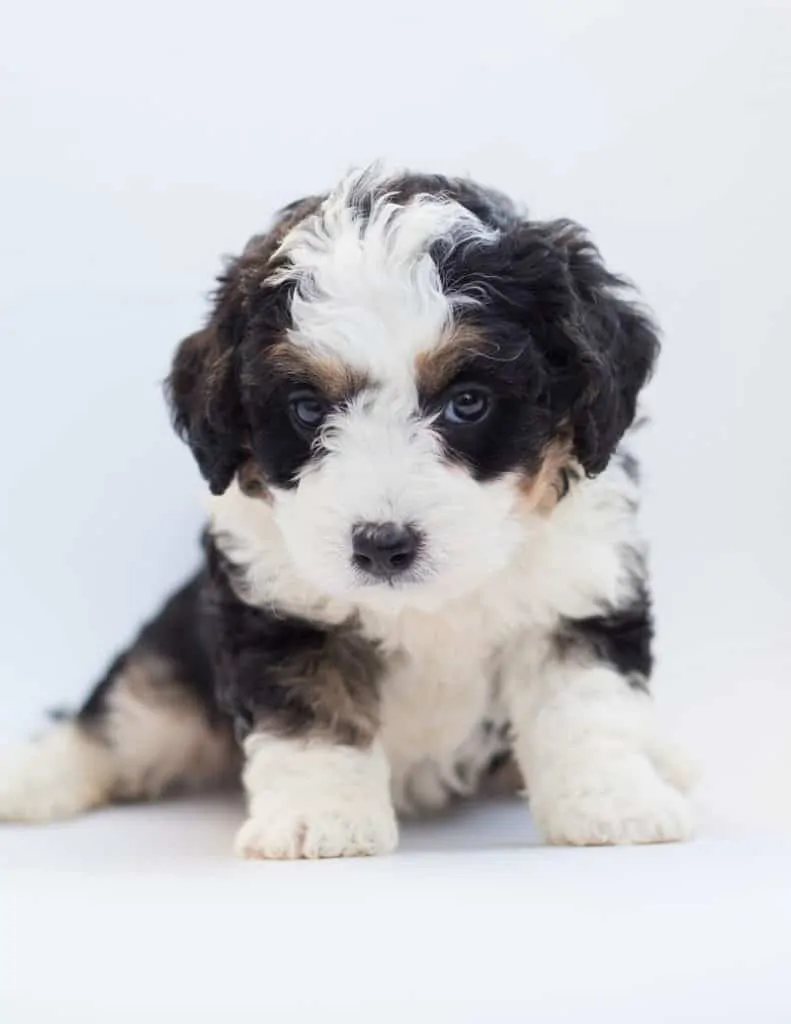
It is rare but not impossible to find different types of Goldendoodle in shelters. Browse local websites and Facebook groups to be notified early. I do see the occasional larger sized Goldendoodle up for adoption in the many rescue communities I am a part of.
Often rehomed Goldendoodles are larger sized with high exercise requirements. If you have an active lifestyle consider adopting a larger Goldendoodle.
Rescuing a Bernedoodle is less common. They are simply a very rare dog, and as a result you will rarely come across Bernedoodles Dogs or Puppies in homes.
When Bernedoodles need rehoming, often the breeders who raised them will help. They are rare dogs, and true Bernedoodle F1 and F1B dogs are expensive. These dogs are less often brought into a home on a whim than other dogs. They rarely require rescue.
The best bet for finding a rescue Bernedoodle is to either be VERY active on the shelters social media. Alternatively contact a breeder and ask about adult Bernedoodle adoption.
So.. Which Breed is Better?
Both the Bernedoodle and Goldendoodle make fantastic family pets. They’re friendly, good with kids, and social with other dogs. However, Bernedoodles can be a bit stubborn and might require a more experienced owner for training.
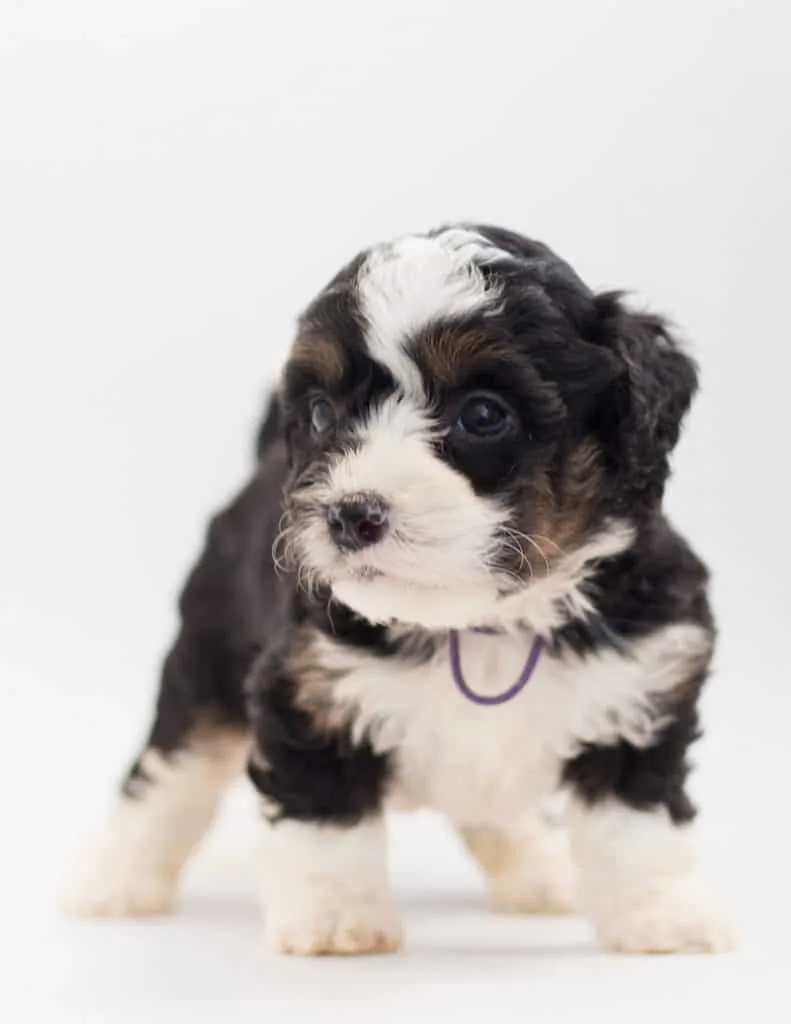
Goldendoodles have more varied coat types and sizes, so scrutinizing the parent dogs can help you predict your pup’s attributes. Both breeds have different size options, and a look at the parents can give you a best guess at your puppy’s eventual size.
Bernedoodles are less common and might be pricier, especially if you’re after the much-desired tri-color. On the other hand, considering an F1B Goldendoodle might give you the benefit of a more hypoallergenic coat. With both breeds, beware of unpredictable traits in second-generation pups, although coat types may be more consistent.
As a family dog expert, I can definitively tell you that overall, there’s no clear winner; both breeds have their merits and would be a delightful addition to any family. Just be prepared for the Bernedoodle’s initial stubbornness and do your homework on coat type if you’re opting for a Goldendoodle.